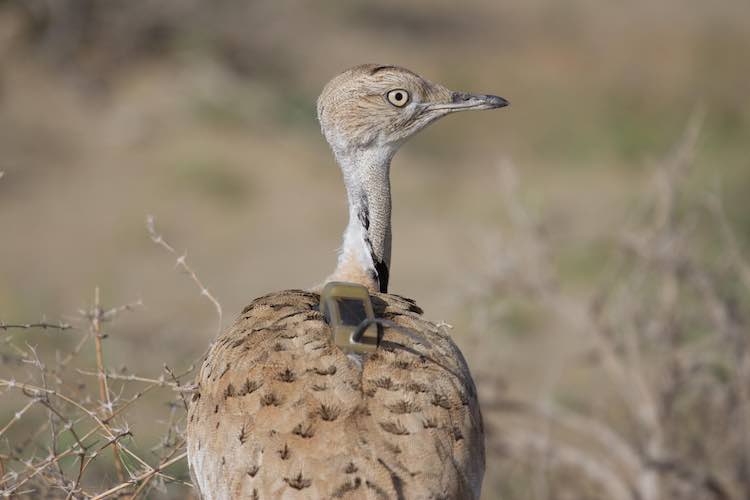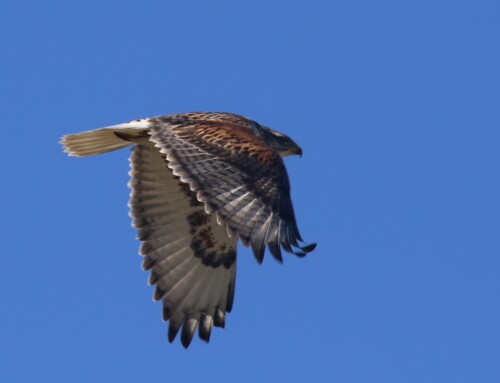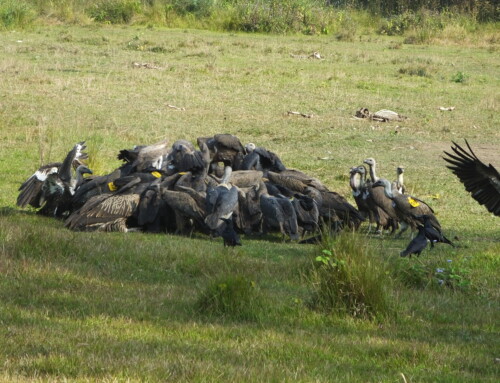Can captive-breeding support the hunted Asian Houbara?
LINKED PAPER
Survival rates of captive-bred Asian Houbara Chlamydotis macqueenii in a hunted migratory population. Burnside, R. J., Collar, N. J., Scotland, K. M. & Dolman, P. M. 2016. Ibis: DOI: 10.1111/ibi.12349. View
The Asian Houbara Chlamydotis macqueenii faces an uncertain future unless legitimate hunting is regulated to a sustainable level and hunt-related poaching on the winter areas is stopped. But what does the scientific evidence say about the role of captive breeding and release in preventing the continuing decline of the Asian Houbara?
Standing in the vast expanses of the Kyzylkum Desert in Uzbekistan, you can begin to understand how untouched the core breeding areas of the migratory Asian Houbara (Fig. 1 & Fig. 2) would have been until the recent past. This was the desert that cast fear into the armies of Peter the Great for its legendary harsh summer heat and freezing winter conditions, but its vast space is no longer enough to protect the Asian Houbara as hunters leave their historic hunting territories in the Middle East and expand their range to pursue this ever-diminishing prize.

The decline of the Asian Houbara is mainly due to unregulated offtake by many different hunting parties within the species’s wintering range states, with no overarching coordination of harvesting rates and no biologically determined sustainable yields. Moreover, poaching occurs in the winter areas to trap live houbara to ship to the Gulf States for falcon training (Combreau et al. 2001, Tourenq et al. 2005, Riou et al. 2011). The decline has not gone unnoticed and, taking the cue from other game species, there has been an effort by some parties to restore and restock populations through captive-breeding and release of the species in the Middle East and now in Uzbekistan and Kazakhstan. On the surface, this seems sensible: hunt some birds―release some birds. However, even with large investments in breeding centres, there has been a continuing decline of Asian Houbara with little recovery of the populations in the Middle East (Allison 2014).
In 2013, I started working with a team led by Dr Paul Dolman from UEA and Dr Nigel Collar from BirdLife International, working in partnership with the Emirates Bird Breeding Center for Conservation (EBBCC) in Bukhara, Uzbekistan. Our aim: to develop and advocate an evidence-based framework for the sustainable management of Asian Houbara, within the province of Bukhara and the central Asian flyway, through engaging with the hunting community. As part of a wider research program into the ecology and demography of the Asian Houbara, we set out to understand the contribution that captive-released birds might make in the quest for sustainable hunting.

We aimed to define what the role of a captive-bred bird was: are they to mitigate the hunting of wild birds by becoming the target quarry themselves, or, are they to compensate for the loss of hunted wild individuals by recruiting into the breeding population? The population in Uzbekistan is migratory, so for a released individual to recruit into the breeding population it must successfully migrate south to Iran, Afghanistan and perhaps even Pakistan and return to Bukhara, twice. To address our aim we used GPS satellite tags to monitor the fates of 65 released birds (see photo top right).
We found that, like other release projects, post-release mortality is a challenge for the recruitment of released birds (Parish & Sotherton 2007, Evans et al.2009, Burnside et al. 2012). After release, two main periods of mortality occurred, immediately post-release and then during the hot summer period (Fig. 3). Nevertheless, 59% of released birds survived to October, when hunting begins. Therefore, to supply one captive bird as quarry for the hunt, 1.7 birds would need to be released. After October, 18 % of birds survived through the migration period to return the following year, giving an overall survival rate from release until the following spring of 11%. Taking into account this first year of post-release survival and an additional year of adult survival to reach breeding age, we estimated that to compensate for the loss of one wild breeder, 13 birds would have to be released – neither practicable nor cost-effective.

A mitigation strategy of releasing birds to be directly hunted could require fewer birds to be released. However, it is not practicable to only hunt captive bred released birds once these have mingled with the existing wild population. Therefore, we took our modelling a step further, and estimated that under a combined mitigation and compensation strategy, to sustainably hunt 200 birds in October would require a release of 1640 birds. Owing to the lower densities of released birds, we found that 79% of the hunted birds would still consist of wild individuals but with 21% consisting of released birds.
Our results emphasise that for fairly modest hunting quotas a lot of birds must be released to sustainably manage a population. Under such a regime, however, there is a risk of gradual decline of the natural capital as most of the hunt bag is composed of wild birds and the breeding population is slowly replaced by released birds. Even though released Houbara have been known to breed, we do not yet know if their productivity rates (chicks fledged) or genetic quality (for example in terms of immune genetics) are fully comparable to wild counterparts.
We believe that this is the first study to specifically address release numbers of captive-bred Houbara with a view to informing sustainable hunting. It shows that scenarios involving compensation are costly due to the large numbers needed and still will not prevent the impact on the wild population. So while captive-breeding can contribute to sustainable hunting, it cannot be the only management strategy. Rather, we still need to develop biologically determined sustainable quotas which are then rigorously adhered to, and, in addition, address the underlying problems of over-harvesting and poaching in winter-range states.
References
Allinson, T. 2014. Review of the global conservation status of the Asian Houbara Bustard Chlamydotis macqueenii. Report to the Convention on Migratory Species Office – Abu Dhabi. Cambridge, UK: BirdLife International. View
Burnside, R. J., Carter, I., Dawes, A., Waters, D., Lock, L., Goriup, P. & Szekely, T. 2012. The UK great bustard Otis tarda reintroduction trial: a 5-year progress report. Oryx 46: 112-121. View
Combreau, O., Launay, F. & Lawrence, M. 2001. An assessment of annual mortality rates in adult-sized migrant houbara bustards (Chlamydotis undulata macqueenii). Animal Conservation. 4: 133–141. View
Evans, R. J., Wilson, J. D., Amar, A., Douse, A., MacLennan, A., Ratcliffe, N. & Whitfield, D. P. 2009. Growth and demography of a re-introduced population of White-tailed Eagles Haliaeetus albicilla. Ibis 151: 244-254. View
Parish, D. M. B. & Sotherton, N. W. 2007. The fate of released captive-reared grey partridges Perdix perdix: implications for reintroduction programmes. Wildlife Biology 13: 140-149. View
Riou, S., Judas, J., Lawrence, M., Pole, S. & Combreau, O. 2011. A 10-year assessment of Asian Houbara Bustard populations: trends in Kazakhstan reveal important regional differences. Bird Conservation International 21: 134-141. View
Tourenq, C., Combreau, O., Lawrence, M., Pole, S. B., Spalton, A., Xinji, G., Al Baidani, M. & Launay, F. 2005. Alarming houbara bustard population trends in Asia. Biological Conservation 121: 1-8. View
Image credit
Featured image: Captive-bred Asian Houbara © R.J. Burnside
If you want to write about your research in #theBOUblog, then please see here.





